sensor BMW 330Ci CONVERTIBLE 2001 E46 User Guide
[x] Cancel search | Manufacturer: BMW, Model Year: 2001, Model line: 330Ci CONVERTIBLE, Model: BMW 330Ci CONVERTIBLE 2001 E46Pages: 215, PDF Size: 2.1 MB
Page 151 of 215
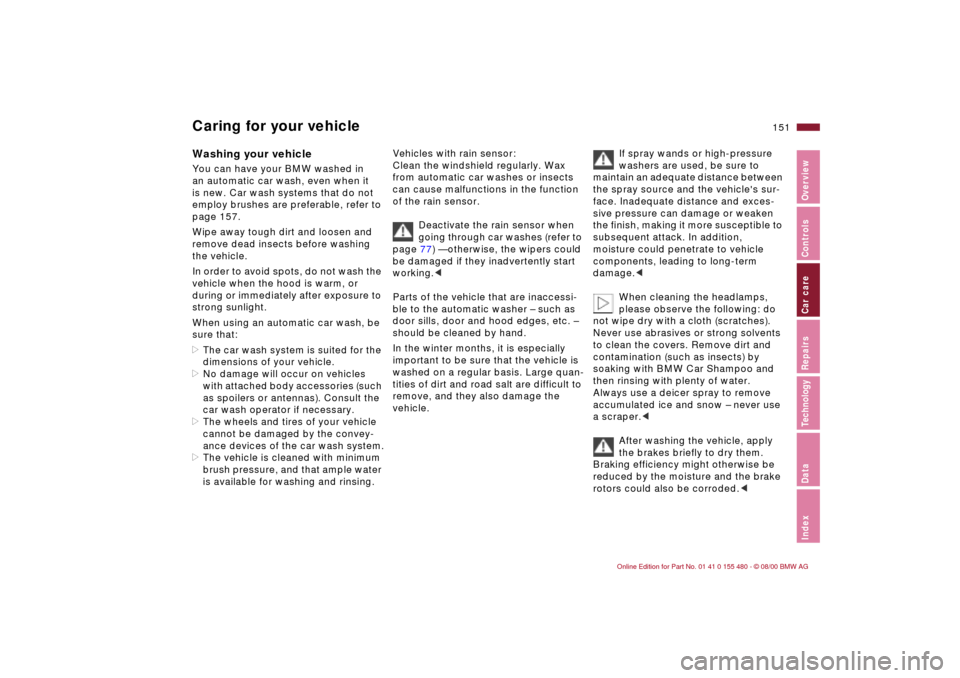
151n
IndexDataTechnologyRepairsCar careControlsOverview
Washing your vehicle You can have your BMW washed in
an automatic car wash, even when it
is new. Car wash systems that do not
employ brushes are preferable, refer to
page 157.
Wipe away tough dirt and loosen and
remove dead insects before washing
the vehicle.
In order to avoid spots, do not wash the
vehicle when the hood is warm, or
during or immediately after exposure to
strong sunlight.
When using an automatic car wash, be
sure that:
>The car wash system is suited for the
dimensions of your vehicle.
>No damage will occur on vehicles
with attached body accessories (such
as spoilers or antennas). Consult the
car wash operator if necessary.
>The wheels and tires of your vehicle
cannot be damaged by the convey-
ance devices of the car wash system.
>The vehicle is cleaned with minimum
brush pressure, and that ample water
is available for washing and rinsing.Vehicles with rain sensor:
Clean the windshield regularly. Wax
from automatic car washes or insects
can cause malfunctions in the function
of the rain sensor.
Deactivate the rain sensor when
going through car washes (refer to
page 77) Ñ otherwise, the wipers could
be damaged if they inadvertently start
working.<
Parts of the vehicle that are inaccessi-
ble to the automatic washer Ð such as
door sills, door and hood edges, etc. Ð
should be cleaned by hand.
In the winter months, it is especially
important to be sure that the vehicle is
washed on a regular basis. Large quan-
tities of dirt and road salt are difficult to
remove, and they also damage the
vehicle.
If spray wands or high-pressure
washers are used, be sure to
maintain an adequate distance between
the spray source and the vehicle's sur-
face. Inadequate distance and exces-
sive pressure can damage or weaken
the finish, making it more susceptible to
subsequent attack. In addition,
moisture could penetrate to vehicle
components, leading to long-term
damage.<
When cleaning the headlamps,
please observe the following: do
not wipe dry with a cloth (scratches).
Never use abrasives or strong solvents
to clean the covers. Remove dirt and
contamination (such as insects) by
soaking with BMW Car Shampoo and
then rinsing with plenty of water.
Always use a deicer spray to remove
accumulated ice and snow Ð never use
a scraper.<
After washing the vehicle, apply
the brakes briefly to dry them.
Braking efficiency might otherwise be
reduced by the moisture and the brake
rotors could also be corroded.<
Caring for your vehicle
Page 154 of 215

154n
Caring for your vehicleWindow careYou can use window and glass cleaner
to clean inside window surfaces and
mirrors without smearing and streaking.
Never use polishing pastes or abrasive
(quartz) cleansers on mirror lenses.
Clean the wiper blades with soapy
water. The wiper blades should be
replaced twice a year Ð before and after
the winter months. This is especially
important for vehicles with a rain
sensor.
Use only wiper blades approved
by BMW.<
Caring for other vehicle
components and materials Light-alloy wheels should be treated
with alloy wheel cleaner, especially
during the winter months. However, do
not use aggressive products contain-
ing acids, strong alkalis or abrasive
cleaning agents, nor steam cleaners
operating at temperatures above
140 7 (+60 6) (follow the manufac-
turer's instructions).
If your vehicle has chrome parts
*, such
as the window frames and door handles,
clean these parts carefully with ample
clean water and a shampoo supplement
if desired, especially if they have an
accumulation of road salt. Use a chrome
polish for an additional treatment.
Plastic components, vinyl upholstery,
headliners (hardtop), lamp lenses, the
clear cover of the instrument panel and
components with a sprayed dull black
surface can be cleaned with water (add
plastic shampoo as required). Do not
allow moisture to soak through the
seats or headliner (hardtop). Never use
solvents such as lacquer thinner,
heavy-duty grease remover, fuels, or
similar substances. Rubber components should be cleaned
with water only; a rubber treatment or
silicone spray may also be applied.
Do not remove safety belts to clean
them. Clean them with mild soapy
water only. Do not use chemicals or dry
cleaners to clean safety belts, since this
could damage the belt fabric.
After cleaning, never allow the inertia
reel to retract the belts until they are
completely dry. Dirty safety belts
prevent the inertia reel mechanism from
retracting the strap properly, and thus
constitute a safety hazard.
Heavily soiled floor carpets and mats
*
can be cleaned with an interior cleaner.
The floor mats can be removed from
the vehicle for cleaning.
Use only a damp cloth to clean trim
panels made of real wood
* and other
parts constructed of real wood
*. Follow
up by drying with a soft cloth.
Use the cleaning and car-care
products available at your BMW
center.<
Page 187 of 215
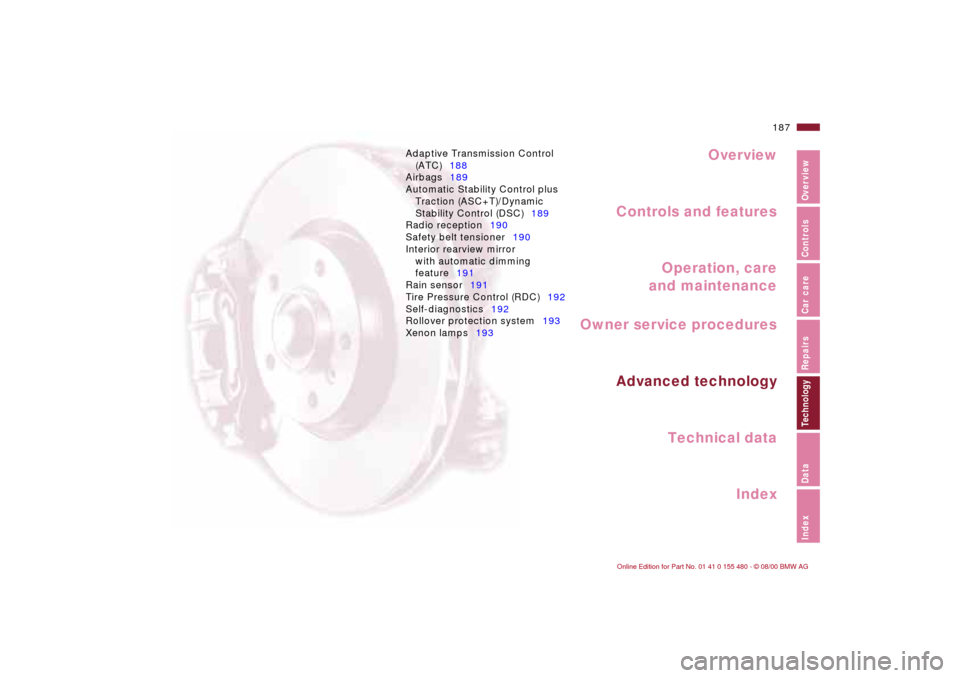
Overview
Controls and features
Operation, care
and maintenance
Owner service procedures
Technical data
Index Advanced technology
187n
IndexDataTechnologyRepairsCar careControlsOverview
Adaptive Transmission Control
(ATC)188
Airbags189
Automatic Stability Control plus
Traction (ASC+T)/Dynamic
Stability Control (DSC)189
Radio reception190
Safety belt tensioner190
Interior rearview mirror
with automatic dimming
feature191
Rain sensor191
Tire Pressure Control (RDC)192
Self-diagnostics192
Rollover protection system193
Xenon lamps193
Technol-
Page 189 of 215

189n
IndexDataTechnologyRepairsCar careControlsOverview
Deceleration sensors continuously
monitor the acceleration forces acting
upon the vehicle. If, as the result of a
frontal collision, a deceleration is
reached at which the protection of the
safety belts alone is no longer
adequate, the gas generators of the
driver and passenger-front airbags are
ignited. However, the passenger-side
airbag is only triggered if an additional
sensor has recognized that the
passenger seat is occupied.
In the event of a side collision, the side
airbags in the front and/or rear
* are
triggered if necessary.
390de012
The airbags located under the marked
covers inflate and unfold in a matter of
a few milliseconds. In this process, they
tear through the designed separation
points of the upholstered covers or
press them out.
Because the inflation process must be
virtually instantaneous, it is accompa-
nied by a certain amount of ignition and
inflation noise, which will be drowned
out by the noise from the accident
itself. The gas required to inflate the
airbags is not dangerous, and the
associated smoke then dissipates.
The entire process is completed within
fractions of a second.Highly sensitive sensors monitor the
number of revolutions of the wheels.
When equipped with DSC, they also
monitor steering angle, lateral accelera-
tion, brake pressure and the movement
of the vehicle around its vertical axis.
If differences in the wheel speeds
occur, ASC+T counteracts the danger
of wheelspin by reducing engine
torque; if necessary, ASC+T will also
respond by applying the brakes to the
rear wheels.
In addition, DSC permanently monitors
the vehicle's current operating condi-
tion and compares it with an ideal
condition that is calculated from the
sensor's signals. If deviations from this
occur (understeering or oversteering,
for instance), DSC can stabilize the
vehicle in fractions of a second by
reducing engine output and with the
assistance of braking intervention at
individual wheels. Dangerous skids are
thus prevented before they can even
start, and all of this is possible, of
course, only within physically possible
limits. You may need some time to
become accustomed to the system's
intervention. However, it provides
optimum drive force and vehicle
stability. The braking intervention may
be accompanied by sounds specific to
the system.
Airbags ASC+T/DSC
*
Page 191 of 215
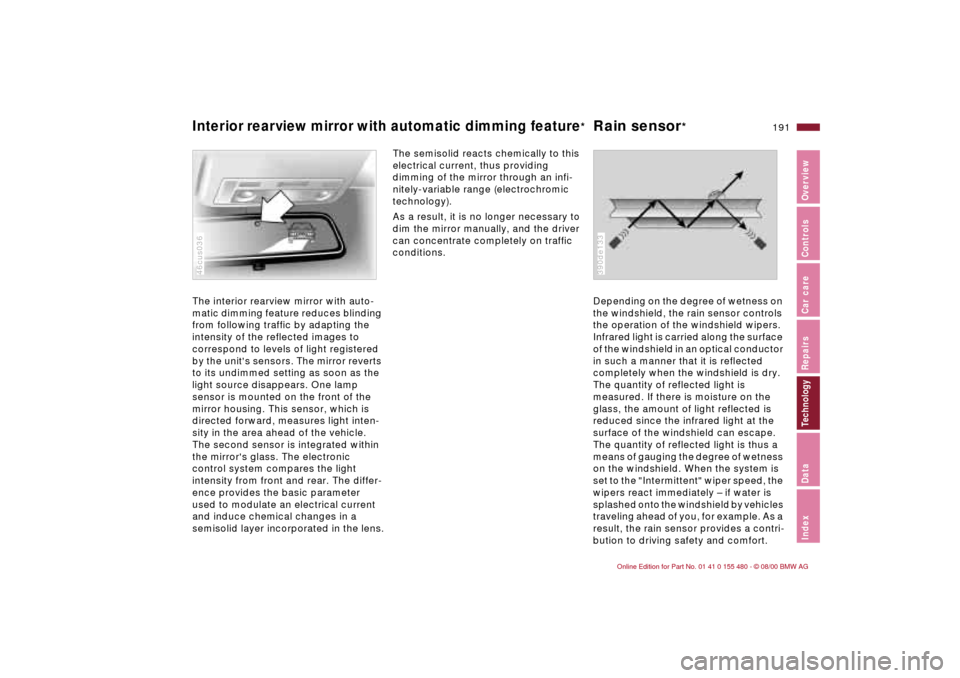
191n
IndexDataTechnologyRepairsCar careControlsOverview
Interior rearview mirror with automatic dimming feature
* Rain sensor
*
The interior rearview mirror with auto-
matic dimming feature reduces blinding
from following traffic by adapting the
intensity of the reflected images to
correspond to levels of light registered
by the unit's sensors. The mirror reverts
to its undimmed setting as soon as the
light source disappears. One lamp
sensor is mounted on the front of the
mirror housing. This sensor, which is
directed forward, measures light inten-
sity in the area ahead of the vehicle.
The second sensor is integrated within
the mirror's glass. The electronic
control system compares the light
intensity from front and rear. The differ-
ence provides the basic parameter
used to modulate an electrical current
and induce chemical changes in a
semisolid layer incorporated in the lens.46cus036
The semisolid reacts chemically to this
electrical current, thus providing
dimming of the mirror through an infi-
nitely-variable range (electrochromic
technology).
As a result, it is no longer necessary to
dim the mirror manually, and the driver
can concentrate completely on traffic
conditions.
Depending on the degree of wetness on
the windshield, the rain sensor controls
the operation of the windshield wipers.
Infrared light is carried along the surface
of the windshield in an optical conductor
in such a manner that it is reflected
completely when the windshield is dry.
The quantity of reflected light is
measured. If there is moisture on the
glass, the amount of light reflected is
reduced since the infrared light at the
surface of the windshield can escape.
The quantity of reflected light is thus a
means of gauging the degree of wetness
on the windshield. When the system is
set to the "Intermittent" wiper speed, the
wipers react immediately Ð if water is
splashed onto the windshield by vehicles
traveling ahead of you, for example. As a
result, the rain sensor provides a contri-
bution to driving safety and comfort.
390de133
Page 192 of 215
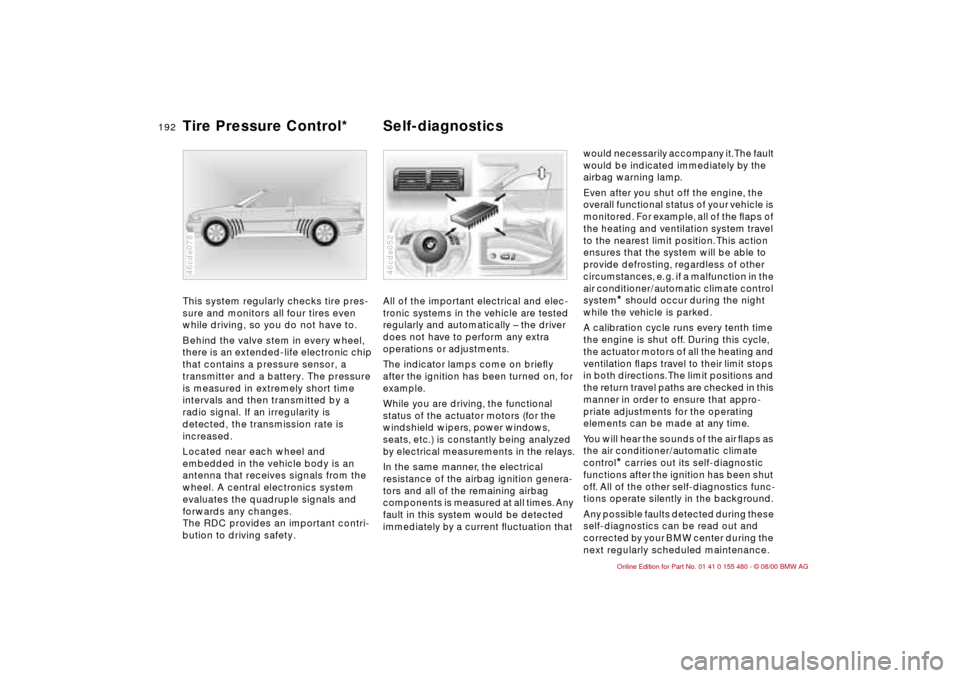
192n
Tire Pressure Control* Self-diagnostics This system regularly checks tire pres-
sure and monitors all four tires even
while driving, so you do not have to.
Behind the valve stem in every wheel,
there is an extended-life electronic chip
that contains a pressure sensor, a
transmitter and a battery. The pressure
is measured in extremely short time
intervals and then transmitted by a
radio signal. If an irregularity is
detected, the transmission rate is
increased.
Located near each wheel and
embedded in the vehicle body is an
antenna that receives signals from the
wheel. A central electronics system
evaluates the quadruple signals and
forwards any changes.
The RDC provides an important contri-
bution to driving safety.46cde078
All
of the important electrical and elec-
tronic systems in the vehicle are tested
regularly and automatically Ð the driver
does not have to perform any extra
operations or adjustments.
The indicator lamps come on brießy
after the ignition has been turned on, for
example.
While you are driving, the functional
status of the actuator motors (for the
windshield wipers, power windows,
seats, etc.) is constantly being analyzed
by electrical measurements in the relays.
In the same manner, the electrical
resistance of the airbag ignition genera-
tors and all of the remaining airbag
components is measured at all times. Any
fault in this system would be detected
immediately by a current ßuctuation that 46cde052
would necessarily accompany it.
The fault
would be indicated immediately by the
airbag warning lamp.
Even after you shut off the engine, the
overall functional status of your vehicle is
monitored. For example, all of the ßaps of
the heating and ventilation system travel
to the nearest limit position. This action
ensures that the system will be able to
provide defrosting, regardless of other
circumstances, e. g. if a malfunction in the
air conditioner/automatic climate control
system
* should occur during the night
while the vehicle is parked.
A calibration cycle runs every tenth time
the engine is shut off. During this cycle,
the actuator motors of all the heating and
ventilation ßaps travel to their limit stops
in both directions. The limit positions and
the return travel paths are checked in this
manner in order to ensure that appro-
priate adjustments for the operating
elements can be made at any time.
You will hear the sounds of the air ßaps as
the air conditioner/automatic climate
control* carries out its self-diagnostic
functions after the ignition has been shut
off. All of the other self-diagnostics func-
tions operate silently in the background.
Any possible faults detected during these
self-diagnostics can be read out and
corrected by your BMW center
during the
next regularly scheduled maintenance.
Page 193 of 215
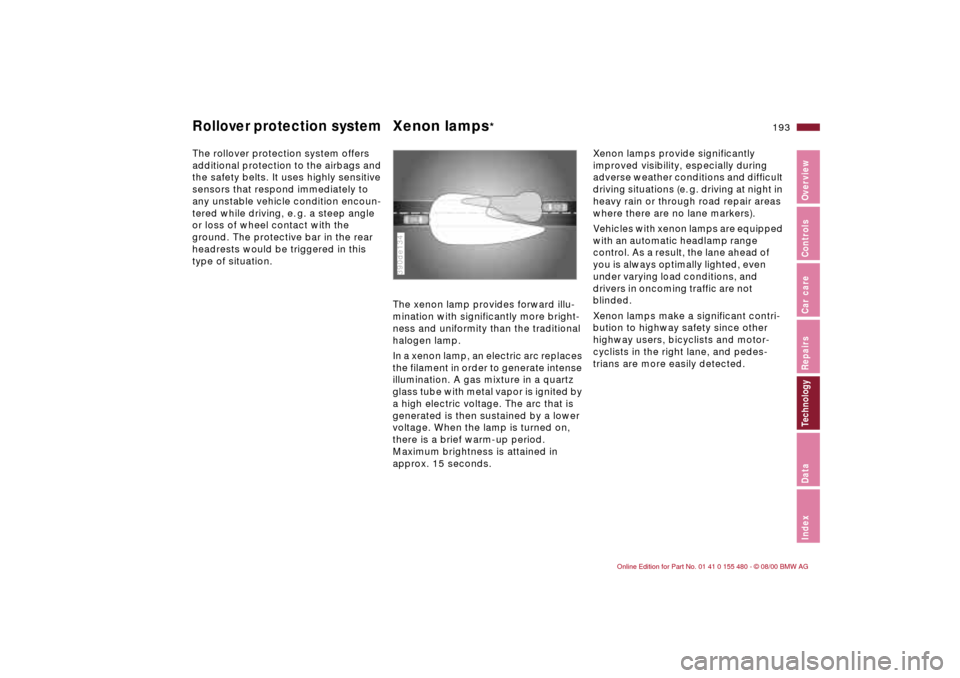
193n
IndexDataTechnologyRepairsCar careControlsOverview
Rollover protection system
Xenon lamps
*
The rollover protection system offers
additional protection to the airbags and
the safety belts. It uses highly sensitive
sensors that respond immediately to
any unstable vehicle condition encoun-
tered while driving, e. g. a steep angle
or loss of wheel contact with the
ground. The protective bar in the rear
headrests would be triggered in this
type of situation.
The xenon lamp provides forward illu-
mination with significantly more bright-
ness and uniformity than the traditional
halogen lamp.
In a xenon lamp, an electric arc replaces
the filament in order to generate intense
illumination. A gas mixture in a quartz
glass tube with metal vapor is ignited by
a high electric voltage. The arc that is
generated is then sustained by a lower
voltage. When the lamp is turned on,
there is a brief warm-up period.
Maximum brightness is attained in
approx. 15 seconds.
390de134
Xenon lamps provide significantly
improved visibility, especially during
adverse weather conditions and difficult
driving situations (e. g. driving at night in
heavy rain or through road repair areas
where there are no lane markers).
Vehicles with xenon lamps are equipped
with an automatic headlamp range
control. As a result, the lane ahead of
you is always optimally lighted, even
under varying load conditions, and
drivers in oncoming traffic are not
blinded.
Xenon lamps make a significant contri-
bution to highway safety since other
highway users, bicyclists and motor-
cyclists in the right lane, and pedes-
trians are more easily detected.
Page 206 of 215

Everything from A to ZEngine
compartment142,143
Engine coolant147,199
Engine data196
Engine oil145
adding145
capacity199
consumption145
disposal147
level check145
pressure20
quality146
specifications146
viscosity146
Engine speed196
Engine, starting69
Engine, switching off70
Enlarging the luggage
compartment41
Enter the rear55
Entry to the rear55
Exterior mirrors57
Eyelets, towing184 F
Failure messages83
Fault, ABS123
Filler cap cover26
Filling capacities199
Filling the washer
reservoir199
First-aid kit25 Fittings, towing and tow
starting184
Flashlight107
Flat tire132,173
Fog lamps94
bulb replacement169
Follow-Me-Home lamps93
Footbrake125
Footwell lamps94
bulb replacement172
Front seat adjusting52
Frost protection,
radiator147
Fuel27
consumption85
gauge82
preparation196
quality27
reserve indicator85
specifications27
tank capacity199
Fuel filler door
unlock in case of electrical
fault180
Functional status of
electrical and electronic
systems192
Fuses179
replacing179
G
Garage-door opener108
Gasoline27
Gasoline gauge82
Glove compartment107
Glove compartment lamp,
bulb replacement172
Gross vehicle weight198 H
Handbrake71
Handsfree system111
Hazard warning flashers25
Hazard warning triangle25
Head restraints53
Headlamp cover,
care151,167
Headlamp flasher76,94
Headlamp washer
system78,144,199
Heated seats107
Heating, rapid100
Heavy loads114
Height197
High beams23,76,94
bulb replacement167
High Performance Synthetic
Oils146
High-mount brake lamp171
Hood, release140
Horn17 Hubcap174
Hydraulic Brake assistant,
refer to DBC
I
Ice warning85
Identification, tires135
Ignition key32
Ignition lock69
Imprint4
Indicator lamps20
Inflation pressure27,132
monitoring91,192
INSPECTION82
Instrument cluster18
Instrument panel16,18
lighting93
Interaxle tire rotation134
Interface socket for Onboard
Diagnostics162
Interference
cellular phones129
Interior lamps36,94
bulb replacement171
remote control36
Interior motion
sensor36,43
Interior rearview mirror58
automatic dimming
feature58,191
Page 207 of 215

Everything from A to Z
207n
IndexDataTechnologyRepairsCar careControlsOverview
Interlock69
Intermittent mode, wiper
system76 J
Jack173
Jump-starting183 K
Key Memory59
Keys32
with remote control32 L
Lamps and bulbs166
LAMPS ON warning93
Lashing eyes115
LATCH attachment of the
child seat64
Leather care155
Length197
License plate lamp, bulb
replacement171
Light-alloy wheels137
Lighter112
Loads, securing114
Load-securing devices115
Low beam headlamps93
bulb replacement167
Lug bolts174 Luggage
compartment40,41
capacity198
emergency release39
floor panel40
lid39
lighting39
lock separately39
remote control36
Luggage compartment
lamps, bulb
replacement172
Luggage rack116
Lumbar support55
M
M+S tires136
Maintenance82,150
Malfunction displays83
Manual convertible top,
operating45
Manual transmission72
Manually controlled
recirculated-air105
Memory57
MFL (Multi-function steering
wheel)24
Microfilter99,180
Mirror memory57
Mirrors57
Mobile phones129 Modifications,
technical6,161
Motion sensor, interior43
Mounting child safety
seat64
Mounting the roof
carrier130
Multi-function steering
wheel (MFL)24
N
Navigation system, refer to
the radio Owner's Manual O
OBD interface socket162
Odometer81
Oil
additives145
capacity199
consumption145
dipstick145
quality146
specifications146
viscosity146
Oil change intervals, see the
Service and Warranty
Information Booklet (US
models)/Warranty and
Service Guide Booklet
(Canadian models) Oil filter change199
Oil level
check145
indicator lamp20
Oil pressure, indicator
lamp20
OILSERVICE82
Onboard tool kit166
Opening and closing
from the inside38
from the outside34
Operating the convertible
top manually in the event
of an electrical
malfunction181
Outside temperature
display84
P
Paint blemishes152
Paint, care152
Paintwork
minor repairs153
waxing153
Park Distance Control
(PDC)87
Parking brake71
Parking help87
Parking lamps94
Parking, winter128
Page 208 of 215

Everything from A to ZPDC (Park Distance
Control)87
Performance196
Phone, mobile129
Pocket flashlight107
Pollen99,106
Power steering129
Power windows44
convenience operation34
Pressure monitoring,
tires91,192
Pressure, tires27,132 Q
Quality Grades133 R
Radiator199
Radio
reception129,190
refer also to the separate
Owner's Manual
Radio Data System
(RDS)190
Rain sensor77,191
RDC (Tire Pressure
Control)91,192
RDS (Radio Data
System)190
Rear lamps169
Rear window
defroster78,98,106
Rear-entry assist55 Rearview mirror57
Recirculated air mode98
Reclining seat52
Refueling26
Remote control35
Remove condensation,
windows105
Replacement keys32
Reporting safety defects7
Restraint system61,64
Reverse17,72
Rollover protection
system67,68,193
Roof load capacity198
Roof-mounted luggage
rack116
Rubber seals and
components127
S
Safety belt tensioner190
Safety belts60
Safety buttons38
Safety defects, reporting7
Seat adjustment52
Seat heating107
Seat memory57
Seat-integrated safety
belts55
Seats52
Securing cargo114
Securing loads114 Selector lever, automatic
transmission73
Self-defrosting mirrors57
Self-diagnostics192
Service and Warranty
Information Booklet150
Service Interval
Display82,150
Shiftlock73
Side airbags61
Side impact Head Protection
System61
Side lamps93
bulb replacement168
Sitting properly with
airbag62
Ski bag113
Skid control128
Slippery roads127
Snow
chains127,136,137
Socket112
for flashlight112
for power supplies112
for vacuum cleaner112
Spare key32
Spare tire173
Spark plugs200
Speaker111
Specifications, fuel27
Speed, average86
Speedometer18
Sports seat54 Starting
problems121,183
Starting the engine69
Steel wheels137
Steering129
Steering lock69
Steering wheel57
adjusting57
Steptronic73
Stopping the vehicle70
Storage compartments110
Storage facilities110
Storing your vehicle160
Stroke196
Summer tires135
Sun visors58
Switching off the engine70
Symbols4,177
Synthetic oils146
T
Tachometer81
Tail lamp assembly, bulb
replacement169
Tank capacity199
Tank cover
unlock in case of electrical
fault180
Technical data196
Technical
modifications6,161
Telephone hookup111